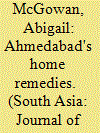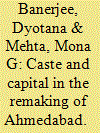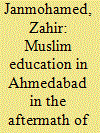| Srl | Item |
| 1 |
ID:
123068


|
|
|
|
|
| Publication |
2013.
|
| Summary/Abstract |
Long known as innovative in modernist architecture, mid century Ahmedabad was also pioneering in another area of built form: housing. Starting in the 1920s when Indians seized control of urban politics, Ahmedabadis launched a number of bold new initiatives to improve housing in the city, involving a striking range of actors-labour activists, middle-class reformers, mill owners, and municipal leaders. Largely ignored under earlier British leadership, housing became a key way for Ahmedabadis to lay claim to a new, more inclusive vision of the city. Although housing continued to play a prominent role in politics after Independence, the 1950s actually marked a retreat from that earlier inclusive vision, ultimately enshrining the class and community segregation that marks Ahmedabad today.
|
|
|
|
|
|
|
|
|
|
|
|
|
|
|
|
| 2 |
ID:
155747


|
|
|
|
|
| Summary/Abstract |
The city has been eulogized as a liberating space of anonymity where identities of caste and creed dissolve before the might of economic capital. This paper examines how the role of caste is both masked and intensified in the formation of new neighbourhoods in the backdrop of city-remaking projects. Our ethnographic study of Dalit-dominated neighbourhoods in Ahmedabad shows that the emergence of a middle-class neighbourhood in Ahmedabad’s periphery must be seen as a ‘post-liberalization Dalit ghetto’ that is distinct from the pre-liberalization Dalit neighbourhoods in the industrial centre of the city. The new Dalit middle-class neighbourhood of Chandkheda is a result of greater economic mobility among Dalits which continues to be marked by the three exclusionary mechanisms: ‘moving up’ and into segregation; caste vigilantism; and protean forms of intra-Dalit exclusion. The collusion of caste and capital produces unexpected forms of space politics that tend to enhance rather than dissolve distinctions based on micro-caste identities in middle-class residential spaces, all the while hiding new forms of exclusion behind the rhetoric of secularized urban development.
|
|
|
|
|
|
|
|
|
|
|
|
|
|
|
|
| 3 |
ID:
127036


|
|
|